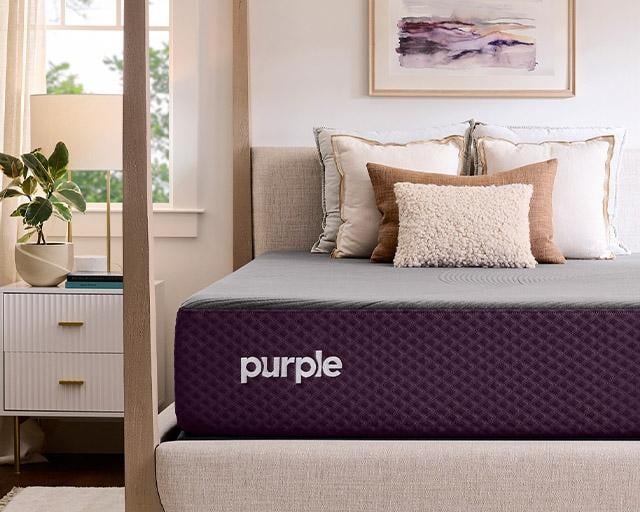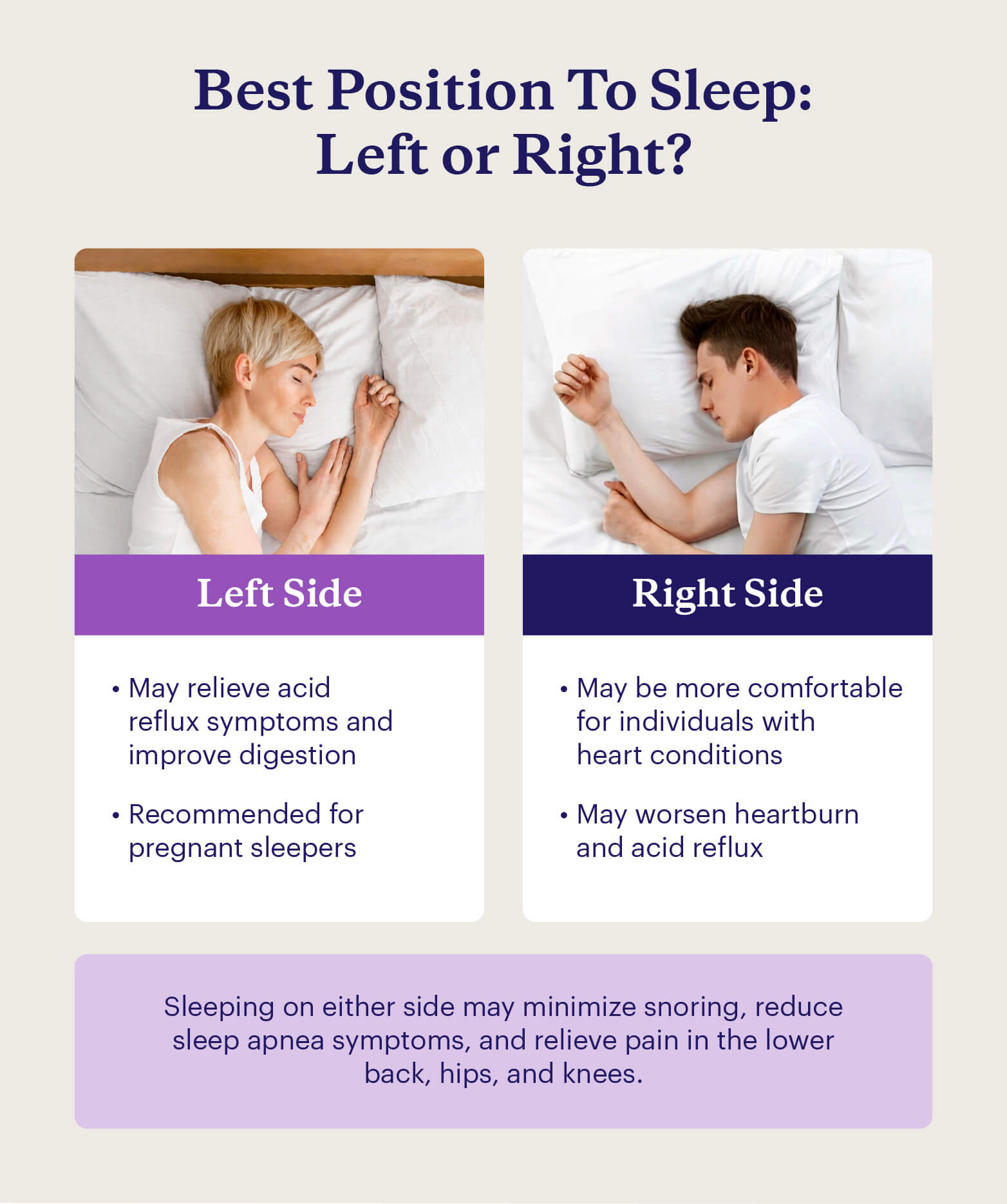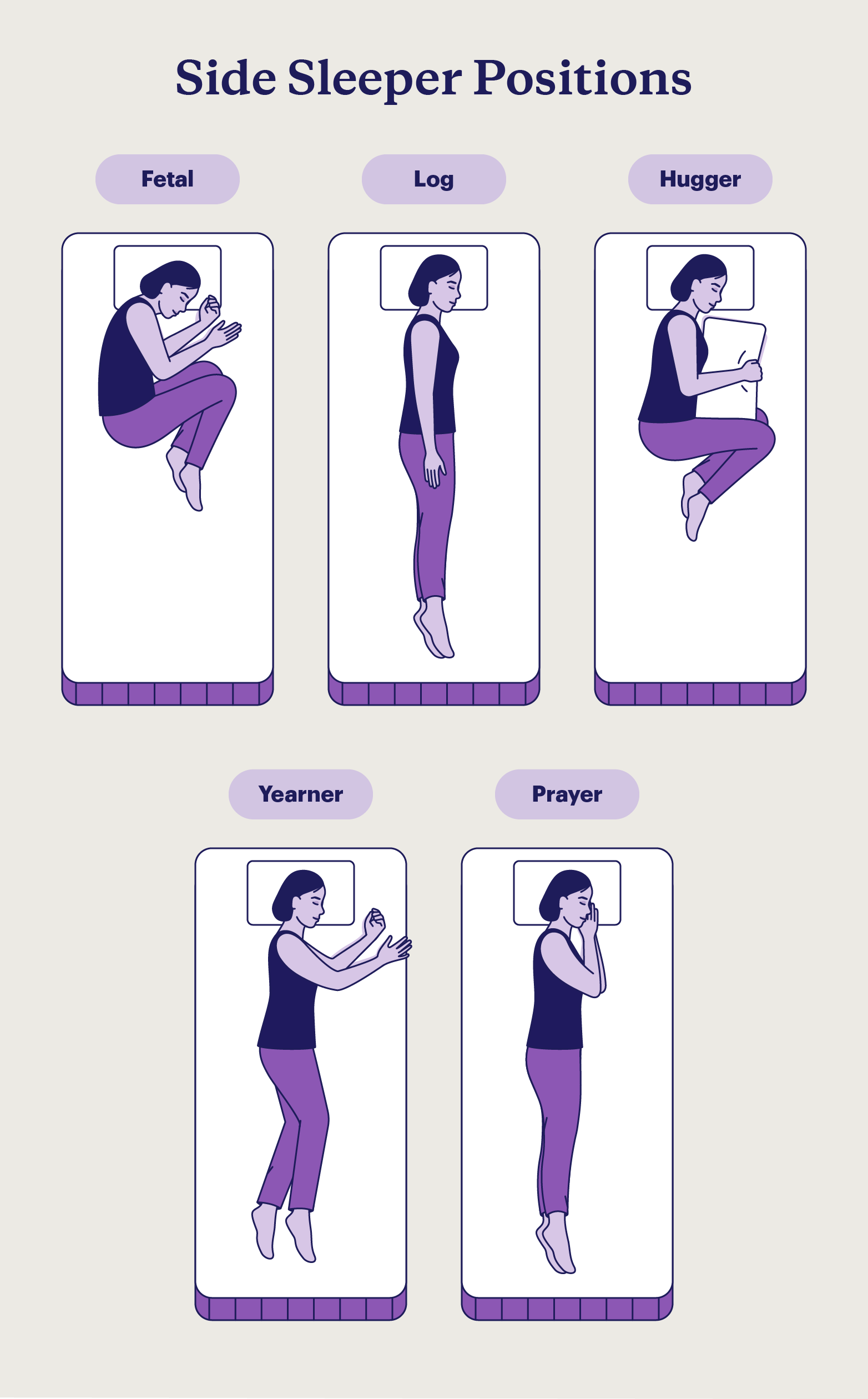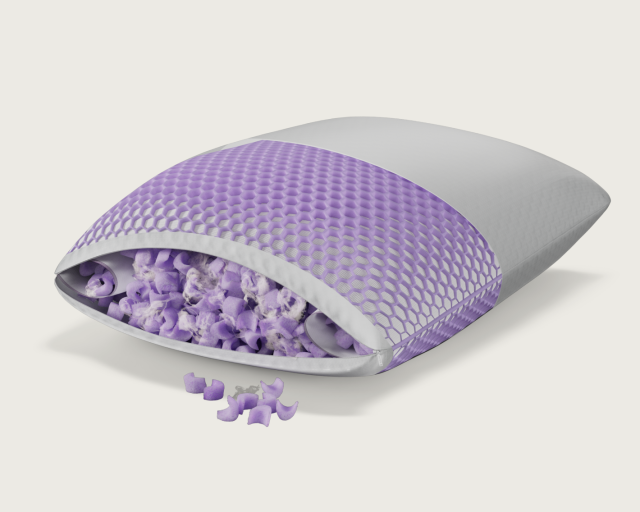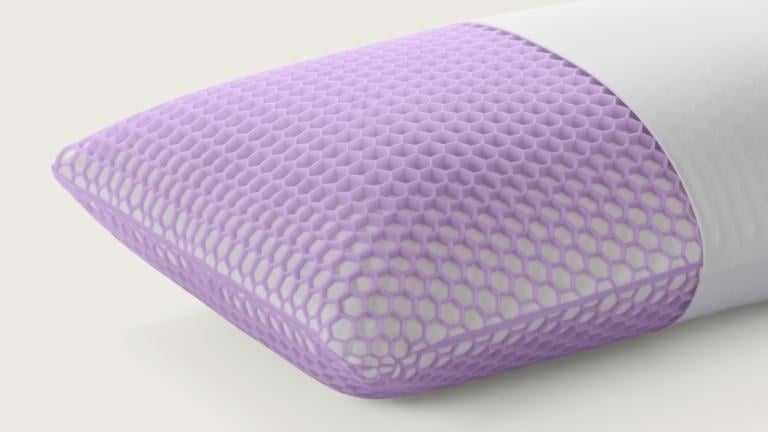
Side Sleepers: Dr. Tips & Recommendations
Key Takeaways
- Side sleeping may help relieve lower back pain, acid reflux, heartburn, and sleep apnea symptoms.
- Sleeping on your left side is generally considered more beneficial than sleeping on your right side.
- Side sleepers should use a medium or high-loft pillow and a medium-firm mattress to promote proper alignment and reduce pain and stiffness.
Around 74% of the world’s population identify as side sleepers.1 As people age, they tend to prefer sleeping on their sides due to the inflexibility of their spines.2
Knowing how to sleep on your side correctly makes all the difference. There are many health benefits to side sleeping, but there are a few drawbacks to consider as well. We partnered with Michael Breus, Ph.D., the Sleep Doctor™ and our Chief Sleep Officer, to help identify the benefits and downsides of side sleeping.
Your sleep quality depends not only on the position you prefer but also on how well your mattress suits your sleep position. If you prefer the side sleeping position, be sure to choose a mattress that keeps your spine aligned and relieves pressure from your hips.
What Is Side Sleeping?
A side sleeper is a person who usually falls asleep on their side and prefers to sleep on their side over any other position. Most people change positions overnight, but side sleepers find that sleeping on their right or left side is the most comfortable.
Side sleepers may place a pillow between their knees to help keep their hips aligned while they sleep. Tucking a pillow between their head and shoulders is also common for side sleepers. Like with other positions, using a pillow properly can alleviate pain and discomfort that can result from misalignment.
Benefits of a Side Sleeping Position
While sleeping positions vary greatly, research shows that side sleeping can have many benefits.
1. Promotes Pain Relief
When you sleep on your side, you relieve pressure from your hips and knees, especially if you put a pillow between your legs. Sleeping on your side can also alleviate lower back pain by reducing the amount of pressure on your spine.
2. May Reduce Snoring
People who sleep on their side may snore less and prevent other problems, like sleep apnea.3 Compared to sleeping on your back, sleeping on your side helps keep your airways open, allowing you to breathe better.
3. May Help Your Digestive System
Sleeping on your side may be good for digestion. Studies suggest that sleeping on your left side may reduce heartburn as well as acid reflux symptoms.4 Our stomachs are naturally positioned on the left side of the body, so sleeping on your left side allows your digestive system to function more optimally.
4. May Improve Brain Health
Your sleep quality affects how well your brain functions, and according to some studies, your sleep position may also impact your overall brain health.5 Sleeping on your side may help improve how your brain gets rid of waste, which can promote better functionality and may reduce the risk of neurodegenerative conditions like Alzheimer’s disease.6
5. Supports a Healthy Pregnancy
Doctors may advise pregnant patients to sleep on their sides to promote blood flow to their baby, kidneys, and uterus. This position can also reduce pressure on the liver and improve circulation.7
|
Pros |
Cons |
|
May relieve lower back pain |
May cause arm numbness |
|
May improve digestion |
May worsen acid reflux and heartburn |
|
May reduce snoring |
May cause shoulder pain |
|
May improve cognitive function |
May increase facial irritation |
|
Recommended during pregnancy |
May be uncomfortable for those with heart conditions |
Is It Bad To Sleep on Your Side? Potential Drawbacks and Considerations
Much like back sleeping, side sleeping can be beneficial in many ways. But you should also consider your personal preferences and sleep needs before trying to change how you sleep.
In some cases, side sleeping may:
- Worsen acid reflux and heartburn: If you sleep on your right side, you may experience more heartburn or acid reflux because of the position of your digestive system. This varies from person to person, so if you don’t experience any issues, you can still get all the benefits of side sleeping by lying on your right side.
- Put additional strain on the heart: Sleepers with heart conditions, like congenital heart failure, may find that sleeping on their left side causes pain, discomfort, and breathing problems.8 For individuals with heart problems, sleeping on the right side may be more comfortable.
- Worsen facial irritation: Sleeping on your side means that your face is usually pressed into your pillow, so compared to back sleepers, side sleepers may have more facial irritation, breakouts, and a higher chance of premature wrinkles. You can mitigate these effects by washing your pillowcases regularly.
- Cause arm or shoulder pain or numbness: Depending on how you position your arms and shoulders while sleeping on your side as well as the pressure relief your mattress provides, you may experience discomfort, numbness, or pain. Improving your sleep posture and choosing supportive pillows can alleviate these issues.
Ultimately, you should choose a sleep position that is comfortable and keeps your spine aligned.
Is Side Sleeping Bad for Your Shoulder?
A common question according to Dr. Breus. To help you learn how to sleep on your side without hurting your shoulder, one of the first things Dr. Breus recommends is to have enough of the right pillows. To minimize the risk of shoulder pain, make sure you have three pillows for support — one for proper neck support, one between your knees, and one more in front of your stomach.
If you have existing shoulder pain, place a pillow against your back or sleep with your back to the wall to keep from returning to the side that hurts. A supportive, adaptive mattress may also help relieve pressure and pain in your shoulder.
Side sleepers may also find that their arm goes numb when sleeping on their side. Numbness in arms while sleeping is especially common for people who sleep with their limbs extended and straight in the log position, which can pin one arm under their bodies and compress the nerves. If you experience arm numbness at night, try adjusting your sleep position or hugging a body pillow to relieve compression.
With a three-inch layer of our GelFlex® Grid, the Purple RestorePlus™ and RestorePremier™ hybrid mattresses provide exceptional pressure relief, reducing the risk of arm pain and numbness.
What Side Should You Sleep On?
Side sleeping may improve your sleep quality and reduce pain regardless of what side you choose, but sleeping on your left side is generally considered to be more beneficial, especially for individuals who have acid reflux or are pregnant.
Sleeping on your right side provides many of the same benefits as sleeping on your left, but it can worsen conditions like acid reflux. However, you can still benefit from a side sleeping position if you prefer to lie on your right side. People with heart problems often prefer to sleep this way because this position may reduce pressure on the heart.
Best Side Sleeping Positions
How you choose to sleep on your side depends on what is most comfortable for you. Regardless of the position you prefer, be sure to choose a mattress firmness that supports your spine and relieves pressure from your hips and shoulders.
One of the most common ways to sleep on your side is with your knees bent and slightly extended past the rest of your body, but there are around five variations of the side sleeper position you can try.
Fetal
In the fetal position, sleepers bring their bent knees close to their chests, sometimes using their arms to hold their knees in place. While this position can be comfortable, sleepers may find that the curvature of their spines causes muscle strain and discomfort over time.
Log
Sleeping in the log position means lying fairly straight with your arms at your sides. This position can cause some discomfort in the knees, which you can alleviate by putting a pillow between your legs.
Lying in the log position can also make your arm feel numb, so rotating positions throughout the night or adjusting your position to reduce pressure on your arm may be beneficial.
Hugger
You may be a hugger if you like holding onto pillows, blankets, or your partner at night. Huggers may keep a pillow close to their chests and wrap their legs around it.
The ideal pillow for huggers may vary depending on personal preference, but a pillow with adjustable firmness like the Purple Freeform™ Pillow is great for customizing how tall and thick you want your pillow to be.
Yearner
Yearners tend to sprawl more than the other positions with their arms outstretched in front of them. While they may keep their legs straight initially, yearners may also spread their legs.
Prayer
The prayer position is a popular choice for those with neck pain. Sleeping in the prayer position means putting your hands together and resting them under your head or pillow to elevate your head and reduce pressure on your neck. Sleepers can have their legs straight or bent depending on what is most comfortable.
How To Sleep on Your Side Properly: Best Practices
Dr. Breus has provided several tips and recommendations to make sure you get the best night’s rest possible as a side sleeper. As you learn how to properly sleep on your side, it may take a few nights to get used to sleeping in a different position, but as you follow these sleep tips, you will notice yourself more easily getting comfortable and falling asleep.
- Find the right mattress firmness: Test mattresses in different firmnesses and determine which one is best for you and your partner. Research shows that people with lower back pain often sleep best on a medium-firm mattress, as a softer mattress may cause back pain.8 Side sleepers generally prefer plush to medium mattress firmness that allows their shoulders and hips to be cradled, alleviating pressure point pain.
- Sleep with a pillow between your knees: Find a flat or low loft pillow like the Purple Harmony Anywhere™ Pillow and place it between your knees while sleeping on your side. Make sure that your hips are aligned, not tilted, and your legs are about shoulder-width apart. Research shows that this will help you avoid hip pain and lower back pain when sleeping on your side.9
- Start on your left side: Lying on your left side may help avoid gastroesophageal reflux disease (GERD) symptoms and heartburn. Try to train yourself to lie on your left side to reap the most benefits from this position.
- Use a thick pillow under your head: You’ll want a pillow like the Purple Harmony™ Pillow that is thick enough to support your head while keeping it in line with your sternum.
- Stretch before bed and when you wake up: Stretching helps loosen up your body before bed and can help in the morning with stiffness. Three simple stretches that most people can do include:
- Side bend stretch: Stand with your feet shoulder-width apart, place both arms straight up over your head, then bend over to your right, hold for 20 seconds. Repeat with your left side for four to five cycles each side.
- Forward bend stretch: Starting with the same position as the above stretch, bend straight forward at the waist and hold for 20 seconds at a time.
- Big arm circles: Rotate your arms in a slow circular motion, extending your arms up as high as you can. Repeat 10-20 times with each arm.
As you implement these tips into your side sleeping routine, you may notice a difference in how you wake up in the morning. Learning how to side sleep properly may take time, but making the transition can be incredibly rewarding.
Best Mattresses and Pillows for Side Sleepers
When it comes to sleeping on your side, your mattress and pillow will play a big role in how you feel in the morning. Choosing mattresses and pillows that support your spine, cushion your pressure points, and relieve pressure will help ensure you stay comfortable and aligned throughout the night.
Mattresses
If you tend to sleep on your side, you may prefer a mattress with a soft to medium firmness. Having the right amount of contouring in your mattress will help protect your shoulders, hips, and spine when sleeping.
Side sleepers may want to steer clear of very firm mattresses as they can cause joint pain from the lack of flexibility on your body’s pressure points.
We recommend the following Purple mattresses for side sleepers:
- Purple RestorePremier™ Hybrid: The Purple RestorePremier™ Hybrid mattress cradles your body to relieve pressure. With Ultra Comfort Foam and CoolFlex™ Coils, this mattress will keep you cool and provide dynamic support. This mattress provides the ultimate comfort and targeted pressure relief for side sleepers.
- Purple RestorePlus™ Hybrid: With our patented GelFlex® Grid and 3 Zone Edge-to-Edge Coils, the Purple RestorePlus™ Hybrid mattress provides core body support for side sleepers.
- Purple RejuvenatePremier™: For maximum comfort and support, the Purple RejuvenatePremier™ mattress features 50% more of our GelFlex® Grid Plus, 5 Zone Edge-to-Edge Coils, and a Quilted Euro Top to adapt to your body and cradle your pressure points.
- Purple Plus®: With our patented GelFlex® Grid technology and twice as much Base Foam as other Essential models, the Purple Plus® mattress provides stability and support for side sleepers.
Pillows
The best pillow for side sleepers will depend on your personal preferences and sleep needs, but you should look for a pillow that provides plenty of support and keeps your neck aligned. Side sleepers tend to prefer pillows with a medium to tall height (or loft) to better support their necks and prevent discomfort.
If you prefer to sleep on your side, we recommend the following pillows:
- Purple Harmony™ Pillow: The supportive, responsive Purple Harmony™ Pillow contours to your neck with a 360-degree wrap of our patented Honeycomb GelFlex® Grid and luxurious latex. This pillow features moisture-wicking mesh to keep you cool and is available in three loft options for every sleep position and preference. Unlike conventional pillows, the Purple Harmony™ Pillow never loses its shape.
- Purple Freeform™ Pillow: The Purple Freeform™ Pillow takes customization to another level with MicroFlex™ Moon Foam that you can add or remove to fine-tune loft and firmness to your exact liking. Paired with a 360-degree wrap of our Honeycomb GelFlex® Grid, this pillow provides support and pressure relief, plus a cool-touch cover for additional cooling. You can also fill the adjustable Neck Roll Chambers for targeted support that keeps your neck aligned.
- Purple DreamLayer™ Pillow: With a layer of our GelFlex® Grid and MicroAir™ Foam, the Purple DreamLayer™ Pillow creates the same conforming comfort of memory foam without trapping heat. While memory foam is slow to respond, the DreamLayer™ Pillow instantly conforms and adapts to your body, providing targeted support where you need it most. This pillow features two removable Booster Layers so you can customize the loft to your preference.
How To Train Yourself To Sleep on Your Side
While the side sleeper position isn’t ideal for everyone, it offers a variety of benefits that make it worth considering. Conditioning yourself to sleep on your side may take some time, but there are a few tips you can use to make the transition easier.
- Choose a supportive pillow: The ideal pillow height for side sleepers may vary depending on personal preference, but you’ll want to use a pillow that fills the space between your head and shoulders to encourage proper spinal alignment and keep you comfortable.
- Put a pillow between your legs: This position straightens your hips into healthy spine alignment, reducing pressure on your lower back, which can offer near-instant pressure relief. You can use a body pillow to promote full-body alignment or a smaller option like the Purple Harmony Anywhere™ Pillow for pain relief.
- Use the tennis ball method: When you want to switch sleep positions, place uncomfortable objects around your body to prevent yourself from rolling around at night.
- Be patient: Making any changes to your habits takes time and patience. If you find the position uncomfortable even after a few nights of trying to train yourself, it may not be right for you.
Ultimately, your comfort takes top priority. No matter what sleep position you prefer, make sure you get high-quality sleep with a supportive mattress that keeps your spine aligned and adapts to your body for maximum comfort.
FAQ
Side sleeping is typically associated with less spinal pain than stomach sleeping, but back sleeping appears to be the best position for back pain relief.10 If you experience back, hip, or knee pain while sleeping on your side, try putting a pillow between your legs to provide some relief.
Sleeping on your left side may reduce acid reflux and heartburn. Your digestive system is positioned on the left side of your body, so lying on this side may promote better digestion. However, there is a chance that sleeping on your right side could make symptoms worse. If you’re a side sleeper with acid reflux or heartburn, you may want to train yourself to sleep on your left side.
You should keep your arms and hands below your shoulders, either straight by your sides or slightly bent, to avoid compressing the nerves in your shoulders. You may also want to sleep with your arms wrapped around a pillow to prevent pain, discomfort, and numbness.
Side sleepers should choose a medium-firm mattress that adapts to the curves of their bodies and provides pain and pressure relief for the hips and shoulders. We recommend a mattress like the Purple RestorePremier™ Hybrid, featuring our adaptive GelFlex® Grid, cooling and supportive Coolflex™ Coils, and Ultra Comfort Foam for superior breathability and pressure relief.
More To Explore
Level up your sleep routine with our most-loved products.


